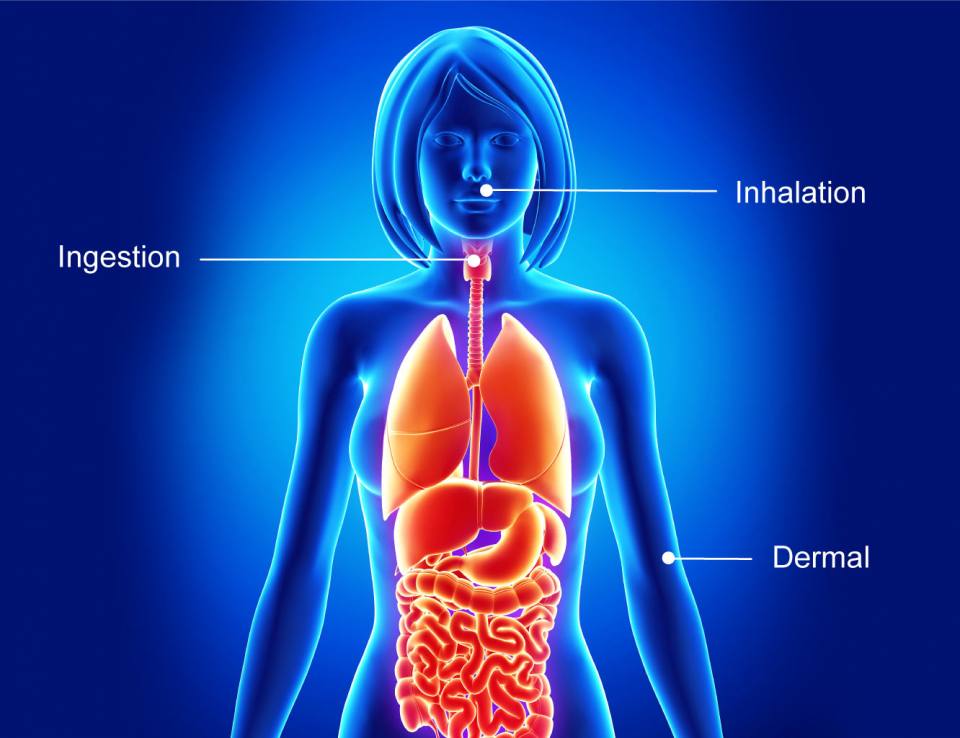People are exposed to potentially harmful substances (PHS) in soil and dust during everyday activities. These include arsenic, lead, cadmium and polyaromatic hydrocarbons. There are three exposure routes: ingestion, inhalation and dermal uptake. The key pathway is accidental ingestion through everyday activities such as gardening and from dust.

There are three exposure routes for contaminants or harmful elements: ingestion, inhalation and dermal uptake. © iStock.com/pixologicstudio.
Exposure measurements are made in the laboratory using in vitro (test tube) experiments simulating the physico-chemical conditions in the human gut and lungs or on the skin. These tests show what may be dissolved in the simulated environment and have the potential to cause harm. We have developed methods with our research partners to simulate the three exposure pathways and the ingestion method is now an ISO standard. For quality assurance purposes, we have produced a guidance soil containing arsenic, cadmium and lead (BGS 102), which is available from the Inorganic Geochemistry Facility.
Key references
Broadway, A, Cave, M R, Wragg, J, Fordyce, F M, Bewley, R J F, Graham, M C, Ngwenya, B T, and Farmer, J G. 2010. Determination of the bioaccessibility of chromium in Glasgow soil and the implications for human health risk assessment. Science of The Total Environment, Vol. 409(2), 267–277.
Cave, M R, Rosende, M, Mounteney, I, Gardner, A, and Miró, M. 2016. New insights into the reliability of automatic dynamic methods for oral bioaccessibility testing: a case study for BGS102 soil. Environmental Science & Technology, Vol. 50(17), 9479–9486.
Cave, M R, Wragg, J, Denys, S, Jondreville, C, and Feidt, C. 2010. Oral Bioavailability. 287–324 in Dealing with Contaminated Sites. Swartjes, F. (editor). (Dordrecht: Springer.)
Cave, M R, Wragg, J, Harrison, I, Vane, C H, Van de Wiele, T, De Groeve, E, Nathanail, C P, Ashmore, M, Thomas, R, Robinson, J, and Daly, P. 2010. Comparison of batch mode and dynamic physiologically based bioaccessibility tests for PAHs in soil samples. Environmental Science & Technology, Vol. 44(7), 2654–2660.
Denys, S, Caboche, J, Tack, K, Rychen, G, Wragg, J, Cave, M, Jondreville, C, and Feidt, C. 2012. In vivo validation of the unified BARGE method to assess the bioaccessibility of arsenic, antimony, cadmium, and lead in soils. Environmental Science & Technology, Vol. 46(11), 6252–6260.
Koch, I, Reimer, K J, Bakker, M I, Basta, N T, Cave, M R, Denys, S, Dodd, M, Hale, B A, Irwin, R, Lowney, Y W, Moore, M M, Paquin, V, Rasmussen, P R, Repaso-Subang, T, Steohenson, G L, Siciliano, S D, Wragg, J, and Zagury, G J. 2013. Variability of bioaccessibility results using seventeen different methods on a standard reference material, NIST 2710. Journal of Environmental Science and Health, Vol. 48(6), 641–655.
Oomen, A G, Hack, A, Minekus, M, Zeijdner, E, Cornelis, C, Schoeters, G, Verstraete, W, Van de Wiele, T, Wragg, J, Rompelberg, C J M, Sips, A J A M, and Van Wijnen, J H. 2002. Comparison of five in vitro digestion models to study the bioaccessibility of soil contaminants. Environmental Science & Technology, Vol. 36(15), 3326–3334.
Van de Wiele, T R, Oomen, A G, Wragg, J, Cave, M, Minekus, M, Hack, A, Cornelis, C, Rompelberg, C J M, De Zwart, L L, Klinck, B, Van Wijnen, J, Verstraete, W, and Sips, A J A M. 2007. Comparison of five in vitro digestion models to in vivo experimental results: lead bioaccessibility in the human gastrointestinal tract. Journal of Environmental Science and Health Part A, Vol. 42(9), 1203–1211.
Wragg, J, Cave, M, Hamilton, E, and Lister, T E. 2018. The link between soil geochemistry in south-west England and human exposure to soil arsenic. Minerals, Vol. 8(12), 570.
Wragg, J, Cave, M, Basta, N, Brandon, E, Casteel, S, Denys, S, Gron, C, Oomen, A, Reimer, K, Tack, K, and Van de Wiele, T. 2011. An inter-laboratory trial of the unified BARGE bioaccessibility method for arsenic, cadmium and lead in soil. Science of the Total Environment, Vol. 409(19), 4016–4030.
Cave, M R, Wragg, J, Beriro, D J, Vane, C, Thomas, R, Riding, M, and Taylor, C. 2018. An overview of research and development themes in the measurement and occurrences of polyaromatic hydrocarbons in dusts and particulates. Journal of Hazardous Materials, Vol. 360, 373–390
Pelfrêne, A, Cave, M R, Wragg, J, and Douay, F. 2017. In vitro investigations of human bioaccessibility from reference materials using simulated lung fluids. International Journal of Environmental Research and Public Health, Vol. 14(2), 112.
Wragg, J, and Klinck, B. 2007. The bioaccessibility of lead from Welsh mine waste using a respiratory uptake test. Journal of Environmental Science and Health Part A, Vol. 42, 1223–1231.
Beriro, D J, Cave, M R, Wragg, J, Thomas, R, Willis, G, and Evans, F. 2016. A review of the current state of the art of physiologically-based tests for measuring human dermal in vitro bioavailability of polycyclic aromatic hydrocarbons (PAH) in soil. Journal of Hazardous Materials, Vol. 305, 240–259.
You may also be interested in

Measuring geochemical hazards
Understanding and assessing geochemical hazards in the environment has been a part of the BGS portfolio of research for over 50 years.



